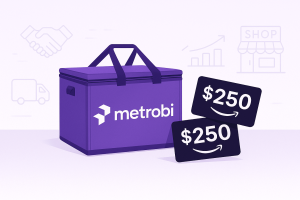Looks like e-commerce isn’t as simple as add-to-cart and checkout, eh? This digital dynamo called online sales trading is bursting with secrets waiting to be decoded – and we’re here to do just that.
Did you know there are nearly 24 million e-commerce sites across the globe? That’s about one e-commerce business for each citizen of Australia.
Now, imagine the competition.
This isn’t your regular high school race. We’re talking Olympics-level hustle.
But don’t sweat. We’re moving beyond the basic ‘what is e-commerce’ question, lifting the veil of the clouded e-commerce world, and serving up some rarely explored insights about online trading. Buckle up and get ready for a journey packed with riveting revelations.
Global Ecommerce Sales 🌐
Global e-commerce sales reached $5.2 trillion in 2021, with Amazon securing 37.8% of the U.S. e-commerce market.
Metrobi drivers are rated 4.97/5
Trusted by local businesses for:
- Background-checked professionals
- Specialized in business deliveries
- Same drivers for consistency
- 4.97/5 average delivery rating
Unraveling Ecommerce: A Comprehensive Guide
So, ecommerce, what is it exactly? How did it evolve? And what are the different types that we can find? Let’s find out!
Understanding the Concept of Ecommerce
First things first, ecommerce is a term for any kind of business, or commercial transaction, that involves the transfer of information across the Internet. It covers a range of different types of online stores, from consumer-based retail sites, through auction or music sites, to business exchanges trading goods and services online between corporations. It’s one of the most important aspects of the internet to emerge.
A bit back in time, the term ecommerce was coined in the 1960s, when electronic data interchange (EDI) and electronic funds transfer (EFT) were introduced. They allowed businesses to send commercial documents like purchase orders or invoices electronically. Then in the 1990s, e-commerce transactions took a new turn with the advent of eBay and Amazon, setting the stage for the booming e-commerce market we see today.
Definition of ecommerce
Simply put, ecommerce stands for electronic commerce. It refers to the transaction of goods or services via the Internet. Think of it as online shopping, but it’s not just limited to products of physical store. E-commerce can also involve digital products, services, and more. Discover the advantages of ecommerce that sells directly to consumers (D2C), enabling companies to engage more intimately with their clientele through online transactions.
Brief history and evolution of ecommerce
Taking a closer look into the past, e-commerce was made possible in 1991 when the Internet was opened to commercial use. From that moment, thousands of businesses have taken up residence on websites, selling everything, from plane tickets to pet food. It’s only grown from there.
Exploring the Different Types of Ecommerce
Now that we’re clear on what e-commerce is and how it’s evolved, let’s dig into its various types. Ecommerce is typically classified into four main categories: B2B (Business to Business), B2C (Business to Consumer), C2C (Consumer to Consumer), and C2B (Consumer to Business). Everything changes depending on the transaction’s direction, whether it’s from a business to a consumer or vice versa. Understanding the different ecommerce models is essential for identifying which approach might best suit your online business needs.
- B2B (Business to Business)
B2B e-commerce is all about transactions of goods and services between businesses. Mostly, it involves wholesale marketing, where one business sells products in bulk to another. It’s like a manufacturer selling to a retailer who then sells to us, the consumers.
- B2C (Business to Consumer)
B2C, on the other hand, is what most people think of when they hear “online shopping”. It refers to transactions between businesses and consumers. It’s businesses selling directly to consumers through their websites. This is where we browse and buy our gadgets, clothes, and more.
- C2C (Consumer to Consumer)
C2C represents a market environment where one customer purchases goods from another customer using a third-party business or platform. Think of second-hand marketplaces, where you can sell your own used items to others.
- C2B (Consumer to Business)
Finally, C2B is a bit of a curveball. In this scenario, consumers are selling products or services to businesses. This might be freelancing platforms, for example. It’s where businesses get to select from a pool of services provided by numerous consumers.
The Power of Ecommerce: Why It Matters
E-commerce holds transformative potential for your business, encompassing convenience, scope, and unbeatable cost-effectiveness. Choosing the right platform can amplify these effects, guiding your business to new heights.
Unveiling the Benefits of Ecommerce
E-commerce is pivotal to running a successful business today. Let’s explore why.
Convenience and Easiness
E-commerce site embraces technology to augment the churning of business in ways physical retailing simply can’t touch. Customers can shop 24/7 without geographic or time constraints, right from their homes.
Wide range of products
Through e-commerce, your business is not confined by brick-and-mortar store, meaning you can offer a wider range of products to customers. This diversity can cultivate a loyal customer base and even attract new clientele.
Lower costs
Lower overhead, such as in personnel and property maintenance costs, can in turn reduce prices, creating more appealing offers to sell online for your customer base.
Speed of transactions
Online platforms can process transactions almost instantaneously. This ensures a better customer experience and quicker returns on investment.
Ecommerce Platforms: Choosing the Right One for Your Business
The choice of an e-commerce platform can make or break your digital venture. Here’s what to consider when making your choice.
Overview of popular ecommerce platforms (Amazon, Shopify, eBay, etc.)
Amazon, Shopify, eBay, and others dominate the e-commerce circle. Understanding their strengths and weaknesses can help you make an informed choice for your business. Discover the top ecommerce platforms to elevate your digital storefront and enhance your business performance.
WooCommerce Dominance 🛒
The average e-commerce conversion rate stands at 3.65%, with WooCommerce holding over 42% of the e-commerce platform market share.
Popularity of Amazon
Amazon accounts for over 13% of desktop visits, selling over 300 million items during Prime Day 2022
Factors to consider when choosing an electronic commerce platform
There’s no one-size-fits-all solution. Factors like your specific business needs, budget, and user interface preferences play a vital role in determining which platform will serve you best.
This information delivery ends here. No final reiterations are in order; the reader is expected to integrate these insights into their online trading understanding, ready to engage with what’s next.
Starting Your E-commerce Journey: A Step-by-Step Guide
Step 1: Identifying Your Niche
In the dynamic landscape of e-commerce, finding your unique market niche is crucial. A well-chosen niche reduces competition and ensures an actively engaged target audience.
The Power of Specialization
By identifying and working in a specific niche, your e-commerce venture can enjoy many benefits – less competition, increased visibility, and a loyal customer base. Plus, narrow focus allows you to tailor your online store and marketing campaign effectively. Finding your niche is not a mere luxury – it’s a strategic necessity in e-commerce.
The Road to Profitability
To find a profitable niche in e-commerce, start by identifying your passion and expertise. Next, conduct thorough market and keyword research to assess potential demand and competition. Analyzing your competitors and target audience’s pain points can also provide valuable insights. Remember, a profitable niche marries your interests with market demand.
Step 2: Selecting an E-commerce Platform
Once you’ve identified your niche, the next crucial step is selecting the right e-commerce platform. This choice can hugely impact the growth and success of your business.
The Choosing Checklist
When selecting an e-commerce platform, consider factors like pricing, ease of use, payment methods, customer service, scalability, and SEO friendliness. Importantly, the platform should align with your business goals and customer expectations.
Giants like Magento, Shopify, and WooCommerce dominate the e-commerce platform market, each offering unique features and advantages. Delve into an unbiased comparison to understand which platform perfectly suits your e-commerce dream.
Step 3: Setting Up Your Online Store
With a distinct niche and a suitable platform in hand, it’s time to set up your e-commerce store.
Your Online Identity
A catchy and relevant domain name builds brand authority and recognition. Ensure the domain is easy to spell, memorable, and reflects your brand’s personality. Exploring domain suggestions can also help you choose a name that resonates with your niche and target audience.
The Digital Storefront
Your website is your digital shop window, an opportunity to make a lasting first impression. Keep the design clean, simple, and user-friendly, ensuring all essential elements – product images, descriptions, reviews, and shopping cart – are readily accessible.
The Checkout Experience
Payment and shipping options have a significant bearing on the checkout experience. Opt for a diverse range of secure payment options and transparent, reliable shipping methods to enhance customer experiences.
Step 4: Marketing Your E-commerce Business
With your online store ready, it’s time to get it noticed. In the digital age, properly executed marketing can make or break your e-commerce business.
The Game Changer
Digital marketing – from SEO to email campaigns – is a powerful tool. Not only does it drive traffic to your online store, but it also converts visitors into loyal customers, uplifting your brand in the process.
The Marketing Mix
Implementing a mix of effective marketing strategies – SEO, social media marketing, email marketing, and more – can exponentially boost your e-commerce business. Each strategy has its strengths, and together they create a synergistic effect.
The Future of E-commerce: What to Expect
Emerging Trends in E-commerce
Mobile Commerce
E-commerce has morphed, taking a road trip onto mobile devices. Mobile commerce is fuelling the growth of e-commerce, with smartphones becoming a trending platform for shopping. With search engines like Google prioritizing mobile first indexing this has become a necessity. It’s no longer a question of whether to implement mobile strategies within your e-commerce business, but rather a question of how soon.
Voice Commerce
The future of e-commerce isn’t just about touchscreens; it’s about making the lines between customer and product as small as possible. Voice commerce epitomizes this trend, with more people using smart assistants like Alexa or Google Home to make purchases. Voice-powered shopping might sound futuristic, but it’s happening right now, and businesses that hop onto this trend early can significantly boost their conversion rates.
AI and Machine Learning in E-commerce
Artificial Intelligence (AI) is not just a buzzword; it’s a game-changer in the e-commerce industry. AI aids in personalizing the shopping experience by analyzing customer behaviors and patterns. It fibers together a better customer experience. Similarly, machine learning, a subset of AI, can help anticipate customer needs and offer suggestions that match their preferences, creating a dynamic, personalized shopping experience. However, businesses must consider the AI integration development cost, which can be significant but often yields substantial returns through enhanced customer engagement and operational efficiency.
The Impact of COVID-19 on E-commerce
Increase in Online Shopping
The COVID-19 pandemic has significantly impacted the global economy. But one sector that has weathered the storm better than others is e-commerce. With people confined to their homes, online shopping has surged. E-commerce has emerged as a lifeline for consumers, offering safety, convenience, and a wide range of goods at a time when brick-and-mortar stores faced severe restrictions.
E-Commerce Fraud Concerns 💼
North America accounts for over 42% of global e-commerce fraud, highlighting the importance of payment security measures. 💳
Changes in Consumer Behavior
The pandemic has not just changed how we shop, but also what we shop. Consumer behaviors have altered significantly, with higher demand for essentials and hygiene products. Many of these changes in consumer behavior are likely to stay long after the pandemic ends. This offers a unique opportunity for e-commerce businesses to adapt and cater to these new needs and preferences.
Preparing Your E-commerce Business for the Future
Staying Updated with Trends
Operating in a vacuum could be the downfall of any business, more so in the rapidly evolving world of e-commerce. Businesses need to keep a close eye on the changing trends and aim to stay at least one step ahead. Embracing new trends such as mobile and voice commerce, can open up new avenues for growth and customer engagement.
Adapting to Changes in Consumer Behavior
The key to adapting to the future of e-commerce lies in understanding and adapting to changes in consumer behavior. Identifying shifts in consumer preferences, whether long-term or caused by events such as the COVID-19 pandemic, can enable businesses to tailor their strategies appropriately.
Investing in Technology
Investing in technology is crucial for any e-commerce business looking to future-proof itself. Embracing AI and machine learning can transform your business, offering a more personalized shopping experience to customers, and equipping you with the data and insights to anticipate and cater to evolving customer needs. Also with that, online stores need to deliver seamless user experiences.
To stay abreast and competitive, you need to identify these trends and swiftly pivot accordingly. Adaptability in the face of change may just be the key ingredient for a long-lasting and successful e-commerce venture.
Digital Wallets
Digital wallets like PayPal and Apple Pay are projected to represent 52.5% of online transaction value by 2025
Decoding the Ecommerce Enigma
Ecommerce, with its vast and complex virtual world, has changed the game for businesses worldwide. The convenience, customer preferences, increasing online user base, and opportunity for global trade are cementing its powerhouse status in today’s economy.
Providing a user-friendly experience, embracing social media marketing, and investing in data protection aren’t just beneficial—they’re pivotal. These gems stack the deck in favor of success in the online trading landscape.
Now, here’s the course you should chart: Set sail for customer-centric design, invest in innovative marketing, and make data security your shield. Remember an online business thrives due to its customers, reaching them effectively and keeping their trust will set you up on the podium.
Consider this: Where does your e-commerce venture stand in terms of customer-centric design, social media campaigning, and data security?
Remember, the world of online trading isn’t for the faint-hearted—it’s for the adventure seekers, the innovators, and visionaries. Venture into the exciting depths of e-commerce—the next big leap could be just a click away.
Grocery ECommerce
By 2027, grocery e-commerce is expected to increase to 13.6%of total grocery sales, showing a significant shift towards online shopping in this sector














